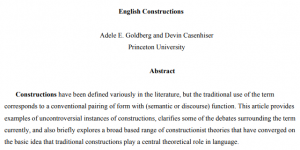PDF #126 – The Great Vowel Shift
The Great Vowel Shift was a series of changes in the pronunciation of the English language that took place primarily between 1400 and 1700, beginning in southern England and today having influenced effectively all dialects of English. Through this vowel shift, the pronunciation of all Middle English long vowels was changed. Some consonant sounds changed as well, particularly those that became silent; the term Great Vowel Shift is sometimes used to include these consonant changes.
English spelling started being standardized in the 15th and 16th centuries, and the Great Vowel Shift is the major reason English spellings now often deviate considerably from how they represent pronunciations. The Great Vowel Shift was first studied by Otto Jespersen (1860–1943), a Danish linguist and Anglicist, who coined the term.
What is the Great Vowel Shift?
The Great Vowel Shift was a massive sound change affecting the long vowels of English during the fifteenth to eighteenth centuries.

Basically, the long vowels shifted upwards; that is, a vowel that used to be pronounced in one place in the mouth would be pronounced in a different place, higher up in the mouth. The Great Vowel Shift has had long-term implications for, among other things, orthography, the teaching of reading, and the understanding of any English-language text written before or during the Shift. Any standard history of the English language textbook (see our sources) will have a discussion of the GVS. This page gives just a quick overview; our interactive See and Hear page adds sound and animation to give you a better sense of how this all works.
The main difference between Chaucer’s language and our own is in the pronunciation of the “long” vowels. The consonants remain generally the same, though Chaucer rolled his r’s, sometimes dropped his aitches, and pronounced both elements of consonant combinations, such as “kn,” that were later simplified. And the short vowels are very similar in Middle and Modern English. But the “long” vowels are regularly and strikingly different. This is due to what is called The Great Vowel Shift.
Beginning in the twelfth century and continuing until the eighteenth century (but with its main effects in the fifteenth and early sixteenth centuries) the sounds of the long stressed vowels in English changed their places of articulation (i.e., how the sounds are made).
Old and Middle English were written in the Latin alphabet and the vowels were represented by the letters assigned to the sounds in Latin. For example, Middle English “long e” in Chaucer’s “sheep” had the value of Latin “e” (and sounded like Modern English “shape” [/e/] in the International Phonetic Alphabet [IPA]). It had much the same value as written long e has in most modern European languages. Consequently, one can read Chaucer’s long vowels with the same values as in Latin or any continental European language and come pretty close to the Middle English values.
The Great Vowels Shift changed all that; by the end of the sixteenth century the “e” in “sheep” sounded like that in Modern English “sheep” or “meet” [IPA /i/]. To many it seemed that the pronunciation of English had moved so far from its visual representation that a new alphabet was needed, and in the sixteenth century we have the first attempts to “reform” English spellings, a movement still active today. In 1569 John Hart (in his Orthographie) went so far as to devise a new phonetic alphabet to remedy what he considered a fatal flaw in our system of language. (His alphabet and the work of other language reformers provides us with our best evidence for the pronunciation of English in his time).
After reading “The Great Vowel Shift” you can check important issues for ESL teachers on the section PDFs, and visit my YouTube channel.




